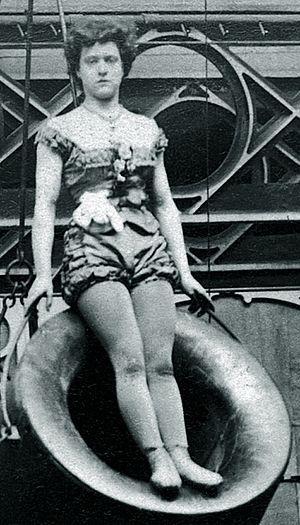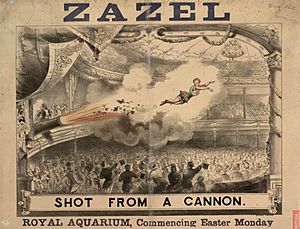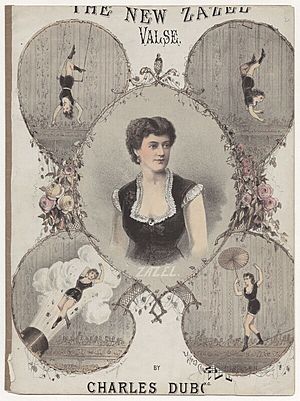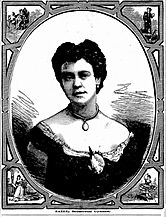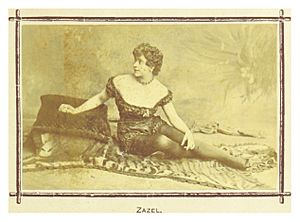Rossa Matilda Richter facts for kids
Rossa Matilda Richter (born April 7, 1860 – died December 8, 1937) was an amazing English performer. She was known by her stage name, Zazel. At just 17 years old, she became famous as the first human cannonball. She started performing very young, practicing aerial stunts like walking on a tightrope in an old church in London. By age six, she was already learning ballet, gymnastics, and trapeze. When she was 12, she traveled with a group of acrobats. In 1877, she made history by being shot out of a cannon for the first time, in front of a huge crowd at the Royal Aquarium.
People, including journalists, worried about her safety from the very beginning of her Zazel performances. A lawmaker even mentioned her as a reason to create new laws in England to stop dangerous acrobatic acts. This led her to take her show to the United States. She toured Europe and North America with famous circuses like Barnum & Bailey. Besides being a human cannonball, she also did tightrope, trapeze, and high dive acts. She had several accidents and injuries during her career. The most serious one in 1891 mostly ended her performing days.
When she wasn't performing with the circus, she started an opera company with her husband. She even sang in some of their shows. She also spent time writing and giving demonstrations to show how safety nets could save lives.
Contents
Early Life and Training
Rossa Richter was born in London in 1860. Her father, Ernst Karl Richter, was a well-known agent who found performers and animals for circuses. Her mother, Susanne Richter, was a circus dancer. Rossa was one of at least four children. As a child, she learned how to fall safely before she learned how to perform. She practiced in an old church in London, where her wire stretched from one end to the other, with nets spread below.
She began performing when she was only four or five years old. She played one of Cinderella's sisters in a play at the Raglan Music Hall. She was just filling in for another child who was sick. But she did so well that she became a favorite and performed more shows at the Drury Lane theatre. She took ballet lessons from a great teacher. Then she learned gymnastics and became a trapeze artist by age six. Her first trapeze show was at the Garrick Theatre. She became famous for a "leap-for-life" stunt on the trapeze, which she did throughout her career. In some of these early shows, she used the stage name La Petite Lulu.
When she was twelve, she joined a traveling group of Japanese or Siamese acrobats. With them, she improved her balancing skills, which were very important for her circus career. They traveled to perform in Dublin, Marseilles, and Toulouse. Even though she was English, a newspaper article said she was known as "the only Japanese girl that ever visited Europe." She even received medals for her bravery and skill. During a show in Toulouse, she had her first accident, falling during a trapeze act. Her injury was serious, and she stopped performing for a short time. Her father said it was because he would not allow her to perform more. Richter returned home to London in 1873.
Becoming the Human Cannonball
The idea for the human cannonball act came from William Leonard Hunt, a Canadian daredevil known as "The Great Farini." He was famous for his own high-wire acts, like crossing Niagara Falls. He also managed other famous performers. Before Richter, Farini's most famous act was his adopted son, Samuel Wasgate. Starting in 1870, Farini dressed Samuel in women's clothes and advertised him as "The Beautiful Lulu the girl Aerialist and Circassian Catapultist." The Lulu act was very popular. It involved Samuel being launched by a catapult into a net or onto a trapeze. His true identity became known only after a serious accident sent him to the hospital.
Lulu's catapult act gave Farini the idea for a cannon act. In 1871, he patented an "Apparatus for Projecting Persons and Articles into or through the Air." When the Royal Aquarium in London hired him to make more money, he did so with amazing acts like the human cannonball.
Rossa's father, Ernst Richter, knew Farini. Years before, he had said he would never let Farini have "a dog of mine, much less a daughter, for his dangerous performances." He even wondered what animal protection groups would say about firing a donkey from a cannon. However, Rossa's mother, Suzanne, was not as careful. Ernst said she tricked him into signing an agreement. He thought it was with a friend and would only involve Rossa singing and dancing.
In April 1877, 17-year-old Richter became known as the first human cannonball in Europe. She performed as "Zazel, the Beautiful Human Cannonball." She was shot out of a spring-style cannon, flew through the air, and landed in a net. People disagree on how far she traveled, saying it was between 6.1 meters (20 feet) and 21.3 meters (70 feet). The cannon used rubber springs to control the distance. Farini also used a gunpowder explosion for a dramatic effect during the show.
Most sources, including the Guinness Book of World Records, say Richter was the first human cannonball. However, some people say "The Australian Marvels," Ella Zuila and George Loyal, did the act a few years earlier.
Richter performed at the Aquarium for a long time, sometimes twice a day. A single show could attract tens of thousands of people. Farini also took her to perform in other places in western Europe. A writer for The Billboard said that the quiet silence before the act made it even more exciting. He added that Zazel's graceful bow always received loud applause. After seeing her many times, a writer for The Illustrated Sporting and Dramatic News wrote a glowing review in 1877. It praised her confidence, graceful movements, and calm, smiling face. The author said that these things made the audience feel no fear for her safety. They could just enjoy her amazing skill and daring acts. The author also noted that future King Edward VII, who was then Prince of Wales, was one of her fans. He reportedly attended two of her shows.
Music often played during her performances. At the Aquarium, the music director, Charles Dubois, wrote waltzes for her. Farini also wrote a song called "Zazel."
The human cannonball was not her only act. Around the same time, she started doing a high dive at the Aquarium. For this stunt, she would jump repeatedly from a high platform into a net. She would slowly increase the distance until she reached a height of 29.6 meters (97 feet). She would start at the top of the stage arch, fall 27.4 meters (90 feet) into the net, then pop up to smile at the audience. She also walked the tightrope. She made it harder by sometimes not using a balancing pole. She would also do tricks like running, standing on one foot, putting baskets on her feet, lying down or sitting on the wire, and spinning around while holding it with her knees.
Touring with Circuses
The relationship between Richter and Farini was more like a manager and employee. Farini kept most of the money from the popular shows. In 1879, a reporter noticed that when Richter traveled, she used a normal train ticket. The reporter thought that those who made a lot of money from her dangerous performances should have paid for a first-class ticket for her. According to P. T. Barnum, who traveled to London to see her perform, Richter begged him to take her away. She was upset about how little money she received from Farini, even though she was the star and took all the risks.
Farini made it clear that the Zazel act belonged to him. When Richter started asking for more money, he secretly began training other young women to perform as Zazel. It's not clear when or how much these other "Zazels" performed. But many acts started using that name, so Richter began calling herself "the original Zazel."
In 1880, Farini and Richter left England. She performed with the Barnum & Bailey Circus for a season, first in France and then in the United States. Her first show in New York on April 8, 1880, was very successful and received loud applause. Even though she was best known as a human cannonball, Richter continued to do other aerial acts, like the high dive and trapeze. She returned to Europe with Farini in November 1881. She stayed a short time and then returned to the United States in 1882, touring with John B. Doris's Inter-Ocean Show.
Opera and Safety Work
Richter married George Oscar Starr, who worked for Barnum. Together, they took some time away from the circus. Among other things, they started the Starr Opera Company in 1886. They wanted their opera shows to be for everyone. They even put on a concert for people in a prison. Even though she wasn't known for singing before, it was said that she sang a song after some circus performances. She played different roles in comic operas. A newspaper said she had an excellent voice and the grace that comes from long experience.
When George Starr was offered a job as managing director of Barnum & Bailey, she decided to return to circus life. She also started using her skills to teach the public and safety workers about how useful safety nets could be. For example, she showed how nets could catch people jumping out of burning buildings. Dressed in normal clothes, she would throw herself out of a building window into a net. An article from 1892 described one such demonstration: "There was never a more fearless woman gymnast than this Zazel, who jumped casually from a fourth-story window into a net to show how nets could save lives."
She volunteered her time for several years to support the use of nets as life-saving tools. Besides doing stunts, she wrote about the topic for people living in large buildings. She worked with The Evening Sun to share her ideas, which started conversations across the U.S. She received thanks from the New York Fire Department for her bravery and advice.
In 1891, while touring the United States, she had a terrible accident during a show in New Mexico. She performed with the cannon and on a tight wire. The wire was about 40 feet off the ground. It ran from the side of the circus tent to two poles in the center. A witness said the poles were supposed to be held together with a steel band, but it was accidentally left off. When she was on the wire, she signaled to her coworkers. They thought she wanted them to tighten the wire. When they did, the poles came apart, and Richter fell to the ground. She landed on her hands and knees, and one of the poles fell on her back. When people picked her up, her body could not straighten. Two men had to pull her shoulders and legs to straighten her. The crowd panicked, and she was heard screaming. The witness said it was "the most horrible accident I ever witnessed." She had broken her back. Local doctors gave her immediate help before she was taken to hospitals in New York. This accident effectively ended her circus career. She spent several months in a full body cast.
Later Life
At some point, Rossa and her husband moved back to England. He died in 1915. He wanted his ashes spread over the ocean between the UK and the US. British laws didn't allow it, but she secretly did it the next year. She then returned to England. In 1933, she said she was living alone in Southern England and enjoyed playing roulette when she could. She died on December 8, 1937, at Camberwell House hospital.
Legacy
Newspapers often wrote about Zazel's amazing performances, her bravery, and her athletic skills. The West Australian wrote that "there was never a more fearless woman gymnast" and that "fear was to her an unknown quantity." Her jumping out of buildings to show how safety nets worked also proved how brave she was, even outside the circus. The Clipper said that "personally Zazel is bright, intelligent and noted for her acts of charity."
Even when she was young, Richter appeared in advertisements for her Zazel performances. The painter George Frederic Watts said she was "the bravest woman I ever saw." When Watts asked her to pose for a painting, her sister came along as a chaperone. Richter later said that she asked her manager if she should donate Watts' painting to the National Portrait Gallery. "He just laughed and said 'whatever would they want in the National Gallery with a picture of you!'". As of 2018, the Gallery has three portraits of her.
Historians Janet Davis and Peta Tait say that circus performers like Richter challenged ideas about what women could do. They showed great strength and agility. Some people even started to think she was a man dressed as a woman. Tait suggested that the cannon act, often at the end of a show, helped balance her other strong acts. It showed her as a "beautiful lady shot from a monstrous cannon," which was seen as more feminine. Shane Peacock described the show: "Farini stood at the cannon, looking evil in his black beard, commanding the sweet, beautiful young Zazel to enter the mortar, and lighting the fuse to a great flourish, sending her across the [Aquarium's] great hall into a net of his own invention." One writer said her nature was "as pure and sunshiny as her face and form were beautiful." Circus promoters often highlighted their female stars' home-loving qualities. This was to make sure they weren't seen as too revolutionary for women's equality. Interviewers asked Richter about circus life. Her marriage to Starr helped discussions about the healthy, traditional lives of performers. She told one interviewer that circus women have a strong desire for home life because they are away from home so much.
Richter's cannon act inspired a scene in the play Little Doctor Faust. The main character would climb into a cannon, then escape through a hidden trap door on the stage. Her costar would use a ramrod to pretend to prepare the cannon to fire. After an explosion, she would run back from the other side of the stage. This act also had an accident when the trap door didn't open. When her costar started using the ramrod, he realized he was hitting her instead of the cannon. He quickly improvised, asking, "Are you in? Are you far in? Are you nearly far in?" This was a pun on her name. The scene and the improvised line were so popular that they were kept in future performances.
Young Man's Fancy, a 1939 British comedy film, had a character based on Richter. Anna Lee played Ada, an Irish human cannonball.
See also
 In Spanish: Rossa Matilda Richter para niños
In Spanish: Rossa Matilda Richter para niños
- Dolly Shepherd
- Edith Maud Cook


